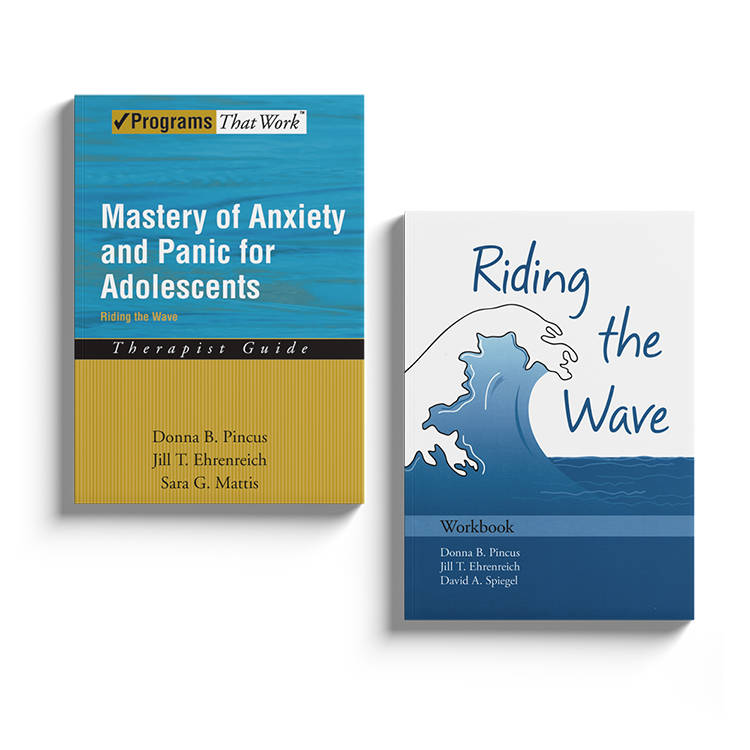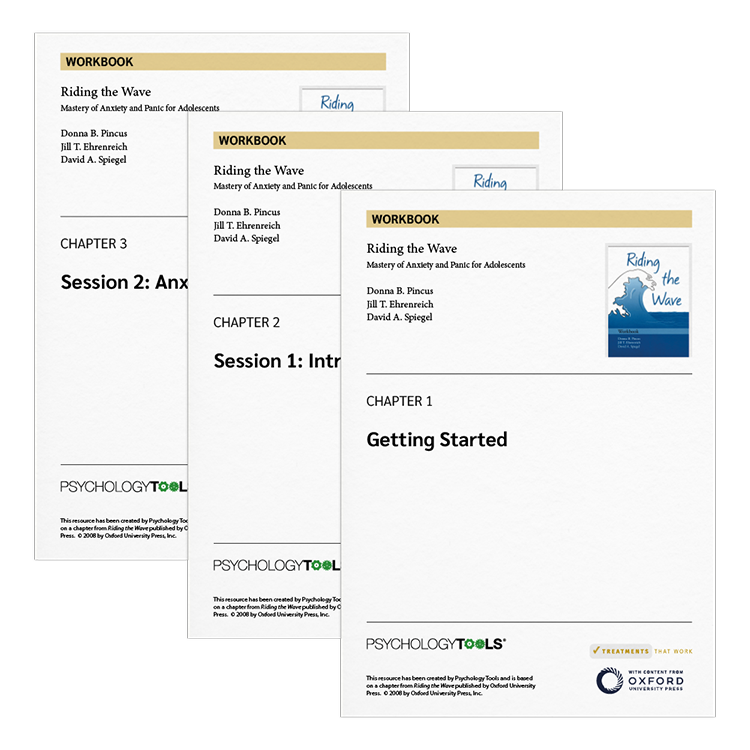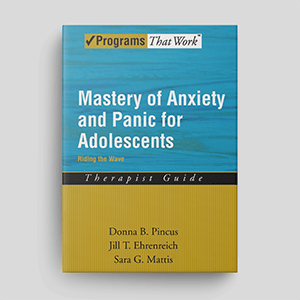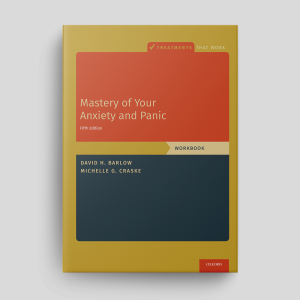Mastery Of Anxiety And Panic For Adolescents: Riding The Wave - Workbook
The Mastery Of Anxiety And Panic For Adolescents: Riding The Wave program provides step-by-step instructions and evidence-based strategies to help teens build resilience and overcome anxiety.

Download or send

Overview
Mastery of Anxiety and Panic for Adolescents: Riding the Wave is a cognitive-behavioral program for adolescents aged 12–17 with panic disorder (PD) or panic disorder with agoraphobia (PDA). Adapted from adult panic control treatment (PCT), it incorporates psychoeducation, cognitive restructuring, interoceptive exposure, and situational exposure to reduce panic symptoms, avoidance, and misinterpretations of bodily sensations. The program includes a Therapist Guide and Client Workbook, plus an optional parent component to support collaborative care. It can be delivered in 11 weekly sessions or an intensive 8-day format, offering flexibility across clinical settings. Research shows significant reductions in panic severity, anxiety sensitivity, and depression, along with gains in confidence, academics, and relationships. Part of the Treatments That Work™ series, this structured, evidence-based program equips clinicians to effectively treat panic and anxiety in young people.
Why use this resource?
This program provides a step-by-step, structured approach for addressing anxiety and panic in adolescents. It provides:
- A structured, step-by-step treatment plan based on CBT principles.
- A parent component to support family involvement and treatment adherence.
- Tools to systematically reduce avoidance behaviors and build resilience.
- Strategies for therapists to help adolescents confront and manage panic symptoms effectively.
Key benefits
Structured
Educational
Effective
Trusted
What difficulties is this for?
Panic Disorder
Recurrent unexpected panic attacks and fear of future attacks.
Agoraphobia
Avoidance of situations due to fear of panic-related distress.
Integrating it into your practice
Assessment
Use structured diagnostic interviews and self-report measures to confirm a diagnosis.
Education
Introduce the three-component model of panic (thoughts, physiology, behavior).
Challenge
Guide adolescents in identifying and restructuring maladaptive thoughts.
Expose
Design and implement interoceptive and situational exposure exercises.
Engage
Involve parents in reinforcing treatment strategies at home.
Monitor
Use worksheets to track progress and adjust interventions accordingly.
Prevent Relapse
Teach long-term strategies for managing anxiety beyond therapy.
Theoretical background and therapist guidance
The Mastery Of Anxiety And Panic For Adolescents: Riding The Wave program is grounded in cognitive behavioral therapy (CBT) principles and represents a developmental adaptation of the well-established panic control treatment (PCT) originally developed for adults (Craske & Barlow, 2006). The adolescent version, referred to as PCT-A, integrates core CBT elements such as psychoeducation, cognitive restructuring, interoceptive exposure, and situational exposure, while also addressing developmental considerations relevant to youth aged 12 to 17. The treatment targets panic disorder (PD), both with and without agoraphobia, and is designed to reduce the cognitive misinterpretations, conditioned fear responses, and avoidance behaviors that sustain panic symptoms (Pincus, Ehrenreich, & Mattis, 2008).
PCT-A is structured around an 11-session model, with the option of a more intensive 8-day version. Early sessions focus on educating adolescents about the nature of anxiety and panic, including the fight-or-flight response and the role of hyperventilation. Cognitive restructuring techniques are introduced to help challenge distorted beliefs about bodily sensations and catastrophic thinking (e.g., fear of fainting or dying during a panic attack). Interoceptive exposure tasks, such as breathing through a straw or spinning in a chair, are used to evoke and then neutralize feared physical sensations. These are complemented by situational exposure exercises that encourage adolescents to gradually confront avoided settings such as schools, shops, or public spaces. The overall goal is to decondition fear associations and improve functioning across multiple domains (Hoffman & Mattis, 2000; Ollendick, 1995).
Empirical support for PCT-A is strong. In a controlled outcome study, adolescents who completed the program demonstrated significantly greater reductions in panic severity, anxiety sensitivity, and depressive symptoms compared to a waitlist group, with improvements maintained at three-month follow-up. Notably, many participants also reported enhanced quality of life and reduced functional impairment. The program includes a parent component, offering caregivers psychoeducation and guidance in supporting their adolescents' treatment goals. This collaborative framework acknowledges the influence of family systems on treatment outcomes and supports the generalization of therapy gains into everyday life (Diler et al., 2004; Mattis et al., unpublished data).

What's inside
- Exercises designed to challenge anxious thoughts and avoidance behaviors.
- Step-by-step exposure plans to reduce fear of panic sensations and situations.
- Worksheets for tracking symptoms, progress, and self-reflections.
- Tools for building long-term coping strategies and preventing relapse.
FAQs
How this resource helps improve clinical outcomes
By incorporating this workbook into therapy, clinicians can:
- Strengthen adolescents' understanding of CBT principles.
- Increase adherence to exposure-based interventions.
- Enhance self-efficacy in managing panic symptoms.
- Improve treatment engagement through structured assignments.
- Support long-term skill development and relapse prevention.
References and further reading
- Craske, M. G., & Barlow, D. H. (2006). Mastery of Your Anxiety and Panic (4th ed.). Oxford University Press.
- Diler, R. S., Birmaher, B., Brent, D. A., et al. (2004). Phenomenology of panic disorder in youth. Journal of Affective Disorders, 80(2–3), 155–162.
- Hoffman, D. L., & Mattis, S. G. (2000). Interoceptive exposure in the treatment of adolescent panic disorder. Cognitive and Behavioral Practice, 7(3), 281–286.
- Ollendick, T. H. (1995). Cognitive-behavioral treatment of panic in youth: A multiple baseline design. Behaviour Research and Therapy, 33(3), 315–319.
- Pincus, D. B., Ehrenreich, J. T., & Mattis, S. G. (2008). Mastery of Anxiety and Panic for Adolescents: Riding the Wave – Therapist Guide. Oxford University Press.
Just enter your name and email address, and we'll send you Riding The Wave: Workbook (English US) straight to your inbox. You'll also receive occasional product update emails wth evidence-based tools, clinical resources, and the latest psychological research.
Product
Company
Support
- © 2025 Psychology Tools. All rights reserved
- Terms & Conditions
- Privacy Policy
- Cookies Policy
- Disclaimer
Working...
We value your privacy
This site uses strictly necessary cookies to function. We do not use cookies for analytics, marketing, or tracking purposes. By clicking “OK”, you agree to the use of these essential cookies. Read our Cookie Policy


